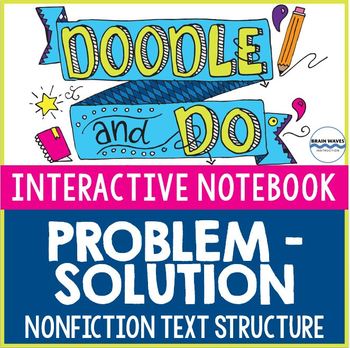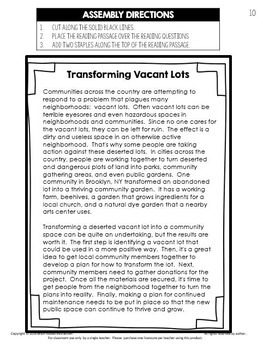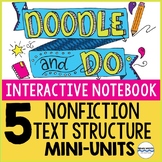Problem-Solution Nonfiction Text Structure - Sketch Notes & Interactive Notebook
- PDF
Also included in
- Teach students all about Nonfiction Text Structures with this bundle of 5 Doodle and Do mini-units! Each are designed for interactive notebooks. With this set of 5 Doodle and Do mini-units, students will complete fun and engaging DOODLE notes where they sketch their notes on each text structure.Price $21.99Original Price $24.95Save $2.96
Description
It doesn’t get more fun than this! Learning about the Problem-Solution Nonfiction Text Structure in the most engaging and interactive ways! First ---- Doodle Notes! Then --- Interactive Notebook Activities!
This “Doodle and Do” resource includes “DOODLE” notes to help students develop understanding of the Problem-Solution Nonfiction Text Structure AND six engaging interactive notebook activities that students can “DO” to help them showcase their learning. Since the sketch notes encourage students to color, doodle, and/or embellish their notes as they learn, they are able to increase their retention of the material. Then, they can take their learning to a new level as they progress through engaging activities that help them develop, showcase, and master their understanding of the Problem-Solution Nonfiction Text Structure. This resource will take at least 3 days to complete.
Great News! This resource is a part of the Nonfiction Text Structures Interactive Notebook Mini-Unit Bundle! The bundle includes Doodle and Do mini-units for each Nonfiction Text Structure: Problem and Solution,Compare and Contrast,Cause and Effect,Description, and Chronological Order.
About the “Doodle” Notes:
Students will develop an understanding of the Problem-Solution Nonfiction Text Structure first by completing a set of doodle notes. Doodle notes are color-it-in, fill-it-in, and doodle-encouraging note sheets. They’re not only visually engaging, they’re also effective in helping students increase their focus and ability to recall information. Plus…they’re really fun! Students glue their doodle notes into their interactive notebooks. In this resource, there are 2 options of Doodle Notes:
- Option 1: All the notes are filled in. With this option students will color, embellish, and add doodles to the notes as you review the information with the class.
- Option 2: Some of the notes are filled in and students need to fill in the remainder of the notes (like guided notes). Students will work to fill in the notes as you teach the content.
About the “Do” Activities
After students complete their Doodle Notes it’s time for them to “Do” some fun interactive notebook activities. The activities are designed around lessons to help students deepen their understanding of the Problem-Solution Nonfiction Text Structure. There are six activities in all:
- Doodle a Solution: Students carry the doodle concept into the first activity where they doodle solutions to four common problems.
- Signal Words Sort: Students learn about the key words that authors use to signal problems and solutions. Then, they sort the words into two categories.
- Problem-Solution Text Structure Matching: Students review 8 problems and 8 solutions. Then, they match each problem with a solution.
- Problem-Solution Text Structure Reading 1: Students read a passage using the problem-solution text structure and then respond to questions using textual evidence.
- Problem-Solution Text Structure Reading 2: Students practice reading another passage using the problem-solution text structure. Then, they respond to reading comprehension questions.
- Problem-Solution Text Structure Writing: Students review the start of a passage that includes just a problem. Then, after analyzing the problem and brainstorming possible solutions, they write the remainder of the passage.
Suggested Sequence & Planning:
Day 1:
• Doodle Notes on Problem-Solution Text Structure
• Doodle a Solution Activity
Day 2:
• Problem-Solution Signal Word Sort
• Problem-Solution Text Structure Matching
• Reading Passage and Comprehension Questions – “Transforming Vacant Lots”
Day 3:
• Reading Passage and Comprehension Questions – “Pollution and Marine Life”
• Problem-Solution Text Structure Writing
This detailed “Doodle and Do” resource includes:
- An overview and set-up of the mini-unit
- Tips and tricks for implementing interactive notebooks
- Doodle Notes lesson plan
- Detailed Lesson Plans for each “Do” Activity
- Doodle Notes – 2 versions! 1 version has all the notes filled in. The other version is missing some information and students are required to fill it in while learning.
- 16 Interactive Shapes!
- Doodle a Solution Activity
- Problem-Solution Signal Word Sort
- Problem-Solution Matching
- 2 Long Reading Passage and Comprehension Questions
- Problem-Solution Writing Prompt
- All Answer Keys
FYI: This unit is also available in a traditional format where students work in student packets. You can check them out here: Problem-Solution – Doodle Notes and Student Packet
Or, you may also like…
- Independent Reading Program - 6-week program – any book!
- Emergency Sub Plans - No copies needed!
Following is Fun!
Get the inside scoop on all store discounts, free products, and product launches. Just click the green “Follow Me” star under my store name on this page or click the green “Follow Me” star on my store homepage.
Let’s Stay in Touch!
*** Click HERE to receive the Brain Waves Instruction Newsletter filled with exclusive FREEBIES and Teaching Tips!
Thanks!
Brain Waves Instruction
Doodle notes is a trademarked term used with permission. Please visit doodlenotes.org for more information.






